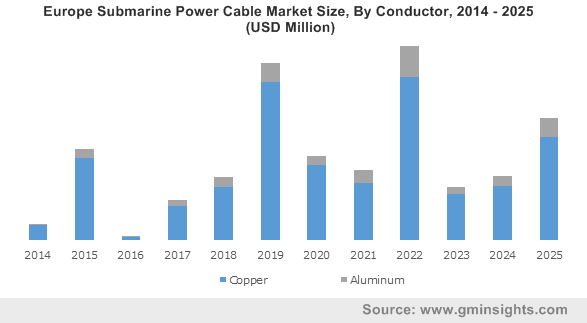Home > Energy & Power > Wire and Cable > Power Cable > Submarine Power Cable Market
Submarine Power Cable Market Analysis
- Report ID: GMI3396
- Published Date: Jul 2019
- Report Format: PDF
Submarine Power Cable Market Analysis
Long route power transfer, minimal transmission losses along with high voltage (HV) power supply are the key factors favouring the deployment of single core submarine power cable market share. Although, high initial cost of installation and poor heat dissipation may hinder the product penetration. However, flexible product specifications, overall operational cost along with ability to endure extreme weather conditions have integrated a favourable business scenario.
Ongoing deployment of offshore wind farms has escalated the demand for multi-core power lines. Moreover, ease of installation on account of effective product specification and short distance power transmission with minimal losses will augment the industry dynamics. Adoption of advance cable laying procedures & technologies and specific regulations for wire burial have further energized the market trends.
Low installation cost along with its large-scale deployment across offshore wind farm establishments have positively swayed the demand for medium voltage cables. Although, they incur high transmission losses and maintenance cost in comparison to HV lines. However, growing dependence on renewable power generation technologies coupled with government reforms & initiatives to create an energy efficient environment will stimulate the overall submarine power cable market demand.
Extra high voltage lines in the recent years have gained significant upsurge owing to the rapid expansion of ultra-high-tension (UHT) transmission lines to endure losses accrued from the long-distance electrical supply. Less utilization of conductor materials, effective long-route transmission of electricity and no sagging losses are the few essential parameters which will fuel the industry demand.
High electrical conductivity and ductility along with non-magnetic properties are some of the key factors positively influencing the product penetration. Copper wires will witness an upsurge on account of properties including ability to bear heavy load surges, corrosion resistant, strength and weight. Moreover, ongoing integration of safe & reliable power transmission systems along with energy efficient equipment will energize the global submarine power cable market share.
Lower material cost, ease of installation along with versatile product configuration when compared to copper wires are few indispensable parameters favouring the deployment of aluminium wires. Moreover, low maintenance cost, longer life span coupled with minimal transmission losses are the factors driving the product penetration. Growing dependence on renewable power generation technologies coupled with industrial integration towards economical and efficient cable technology will stimulate the overall business scenario.
Rapid increase in island interconnections and deployment of offshore wind farms will positively influence the market expansion. Although, high cost of installation, complex authorization and stringent norms pertaining to the marine conservation may hinder the product demand. However, safe & reliable offshore power transmission and lesser line losses will further sway the technological adoption.
Submarine power cable market is positively influenced by various regulatory reforms including leveraging schemes, incentives and subsidies coupled with increasing government investments to integrate an energy efficient environment. As per IEA, increasing offshore oil & gas production will enhance investment in offshore wind farms propelling the business scenario. Furthermore, growing inclination towards the renewable power generation in line with rising deployment of offshore wind farms across the globe will strengthen the business landscape.
European submarine power cable market exceeded USD 2.5 billion in 2018. The industry is driven by ongoing advancements toward an effective transmission network along with soaring energy demand from developing countries. Stringent norms pertaining to efficient power transmission coupled with increasing cross-border electricity trade will further thrust the regional industry dynamics.

